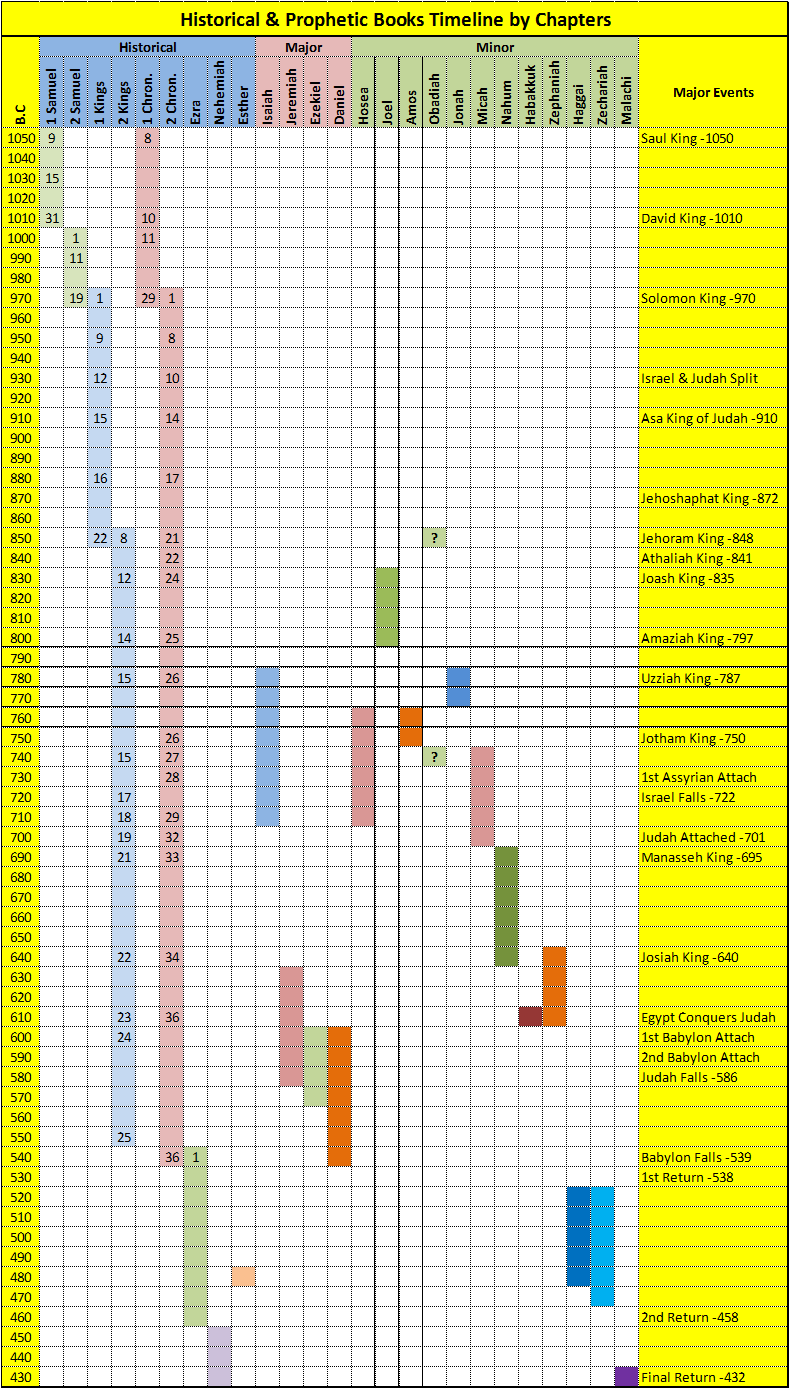INTRODUCTION TO 1 and 2 CHRONICLES
QUESTIONS FOR STUDY ONE
OUTLINE
ISRAEL'S HISTORY
MAJOR EVENTS FROM BABYLON TIMES TO ROMAN OCCUPATION OF JUDAH
Before analyzing the test of any book of the Bible, it is well to learn the historical background.
Also, it is best to make a "skyscraper" view of its general contents. Accordingly, this introduction is divided into two parts: background and survey.

- BACKGROUND
- Author.
- According to ancient Jewish tradition, Ezra wrote Chronicles, Ezra and Nehemiah, but this cannot be established with certainty. A modern consensus dates Chronicles in the latter half of the fith century B.C., thus possibly within Ezra's lifetime. And it must be acknowledged that the author or authors, if not Ezra himself, at least shared many basic concerns with that reforming priest, though Chronicles is not so narrowly "priestly" in it sperspective as was long affirmed.
- Some believe the text contains evidence here and there of later expansions after the basic work had been composed. While editorial revisions are not unlikely, all specific proposals regarding them remain tentative.
- The chronicler(s) relied on many written sources. About half of the work was taken from Samuel and Kings, as well as the Pentateuch, Judges, Ruth, Psalms, Isaiah, Jeremiah, Lamentations, and Zechariah. Also, there are frequent references to still other sources: "the book of the kings of Israel", "the book of the annals of King David", "the book of the kings of Judah and Israel" or "the book of the kings". It is unclear whether these all refer to the same cource or to different sources, and what their relationship is to Samuel and Kings or to the royal annals referred to in Kings. In addition, the author cites a number of prophetic writings: those of "Samuel the seer", "Iddo the seer", "Shemaiah the prophet", "the prophet Isaiah", "the seers". All these are used, often with only minor changes, to tell this collective story of the past. Nothing is invent. Rather its selected, arranged, and integrated into sources to compose a narrative for postezilic Israel as they struggled to reorient as the people of God in new situatinos.
- Date and Place of Writing
- The date of Chronicles is about 400 B.. Chronicles uses sources from an earlier period, particularly the canonical works of Genesis, Samuel, and Kings.
- Addressee
- The book is clearly addressed to the Jews who would return to Palestine as Jeremiah foretold.
- Occasion and Purpose
- Writing in neither the best of times nor the worse of times for the Jews, the Chronicler sought to give hope to a people returning from exile and punishment. Adrift in a see of transition, they were tempted to doubt God's promises and be disillusioned over past failures. They had gone from the military might of David and the material splendor of Solmon to the humiliation of the Asserian and Babylonian captvity. The Jews, as they were first called by the Babylonians needed to understand ther roots and hear a reaffirmation of God's covenat promises to Israel.
- Chronicles was written to call Israel back to its covenant commitments. The author(s) wrote not from the perspective of bitterness but from brokenness and from faith in God's continuing purpose for his people. The book depicts the ongoing plan of grace and redemption from Adam to the pst-Exilic community. Chronicles used history to teach Israel the lesson of history and their own past failures. god will not tolerate disobedience even from the chosen people. He will hear the prayer of penitence, for his final word is one of grace and mercy.
- Form and Style
- FORM.
1 and 2 Chronicles is actually one scroll (book) divided into two because it is to long to be one scroll.
- STYLE.
1 and 2 Chronicles is historical with a few small instructions and insights.
- Place Among the Old Testament Books
- 1 and 2 Chronicles is placed amongst the historical books of the Old Testiment.
- The placing is directly after 2 Kings and before Ezra's historical book.
SURVEY
The Books of 1 and 2 Chronicles provide a prophetic interpretation of the history of Israel. The book stars with a long though not complete list of geneologies from Adam to King Saul and King David (chapters 1 thru 9). The rest of 1 Chronicles recounts David's kingdom.
2 Chronicles starts with the reign of King Solomon and continues to the decree of Cyrus, king of Persia that permitted the Jews to return to Israel. The reign of Solomon was a time of unprecedented glory. However, Solomon's glory stemmed mainly from the blessings of God upon him for David's sake rather than for Solomon's own personal goodness. Although Solommon loved the Lord, his devotion was tainted by disobedience. In his later life his disobedience lead to his apostasy which caused the kingdom to be divided in the days of his son. Solomon's sin cast a spell of doom across his wisdom, wealth, and building achievements.
The kingdom was divided into Judah and Israel after Solomon died until the fall of Israel in 722 B.C. Israel (the Northern Kingdom) was born in sin. Its first king, Jereboam, led the people from the true worship of God into a false worship of God under the figure of the fertility calf that involved ritual prostitution. Israel never had a king that did right in the sight of the Lord and never ixperienced a revival of tru religion. In contrast, many kings of Juday (the Southern Kingdom) were devoted to the Lord God of Israel, if not with a perfect heart. Moreover, Judah experienced revivals from time to time by which the people were brought back to God. One ruling house after another arose to fall in Israel. In conract, throught these turbulent years God maintained a son of David upon the throne of Juday in Jerusalem in faithfulness to his promise (2 Sam. 7).
Judah stood alone from 721 B.C. until 587/6 B.C. when they were swept away into the Babylonian captivity. The godly reign of Hezekiah before the exile brought fleeting hope for Judah's salvation, but the unprecedented wichedness of Manasseh's reign led Juday to cross the line of God's mercy; thereafter, he marked Judah for destructin. Even the repentance of Manasseh in his later years and the godly reforms of Josiah could not avert Judah's plunge to destruction. After deportations in 605 B.C. and 597 B.C., the end finally came in 587/6 B.C. with the fall of Jersalem after the combined wicked regns of four kings. The destruction of Jerusalem and the exile in Babylon did not mark the end of God's people, only his chastisement of them. Significantly, the Book of 2 Kings concluded with Evil-Merodach's gracious care of Jehoiachin. This even foreshadowed the good that God would yet bring upon his people in fulfillment of his promise to David to "establish the throne of his kingdom forever" (2 Sam. 7:13).
STUDY 1 QUESTIONS
STUDY 1 COMMENTS

Click the house to go to the Bible Study HOME Page
|
























